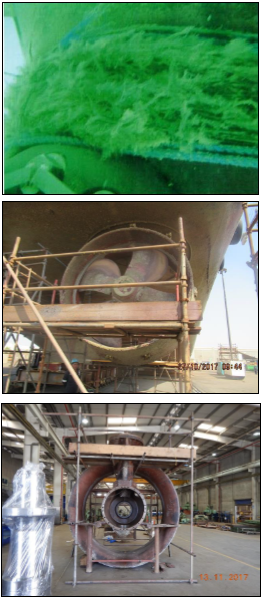Costly damage to azimuth thruster caused by fishing gear
What happened?
A vessel equipped with two azimuth thrusters, was performing operations alongside an offshore platform, when inappropriate vibrations were noted from the starboard azimuth thrusters and its hydraulic pump.
Investigation revealed the presence of seawater in the thruster oil system. The vessel left the platform using the port engine only and an underwater survey of the propellers was carried out on location. That underwater inspection showed rope and fishing nets fouling the starboard propeller and azimuth unit. The presence of oil around the propeller hub was also noted. The vessel had to go into dry dock, and the thruster assembly, including propeller blades and Kort nozzle, had to be removed for repair.
Repairs cost hundreds of thousands of dollars and the vessel was off hire for nearly ninety days.

What went wrong? What were the causes?
- Rope and fishing net fouling found on the starboard azimuth thruster;
- The seal was damaged by the fishing net;
- Seawater presence was observed in the hydraulic system;
- Reduced lubrication quality of the hydraulic oil caused damage to thruster components;
- Vibrations were noted on the hydraulic pump. Suction filters were found clogged with water and oil residues.
During the overhaul, additional delays were caused by:
- Some parts which were not included in initial order for the full overhaul scope;
- Delay in spares delivery by the manufacturer.
What lessons were learned?
The thruster manual states the hydraulic oil should be visually inspected daily; this was arranged by crew, but the task was not present in the planned maintenance system (PMS).
What actions were taken?
- Crew should check equipment manuals and ensure correct maintenance intervals have been added to the PMS;
- Manufacturer to study the possibility of installing a net cutter on the propeller shaft;
- In order to recognize water ingress caused by leakage quickly, equipment to facilitate random chemical sampling to determine water content should be installed.
Members may wish to review the following:
Safety Event
Published: 17 September 2018
Download: IMCA SF 21/18
IMCA Safety Flashes
Submit a Report
IMCA Safety Flashes summarise key safety matters and incidents, allowing lessons to be more easily learnt for the benefit of all. The effectiveness of the IMCA Safety Flash system depends on Members sharing information and so avoiding repeat incidents. Please consider adding [email protected] to your internal distribution list for safety alerts or manually submitting information on incidents you consider may be relevant. All information is anonymised or sanitised, as appropriate.
IMCA’s store terms and conditions (https://www.imca-int.com/legal-notices/terms/) apply to all downloads from IMCA’s website, including this document.
IMCA makes every effort to ensure the accuracy and reliability of the data contained in the documents it publishes, but IMCA shall not be liable for any guidance and/or recommendation and/or statement herein contained. The information contained in this document does not fulfil or replace any individual’s or Member's legal, regulatory or other duties or obligations in respect of their operations. Individuals and Members remain solely responsible for the safe, lawful and proper conduct of their operations.
